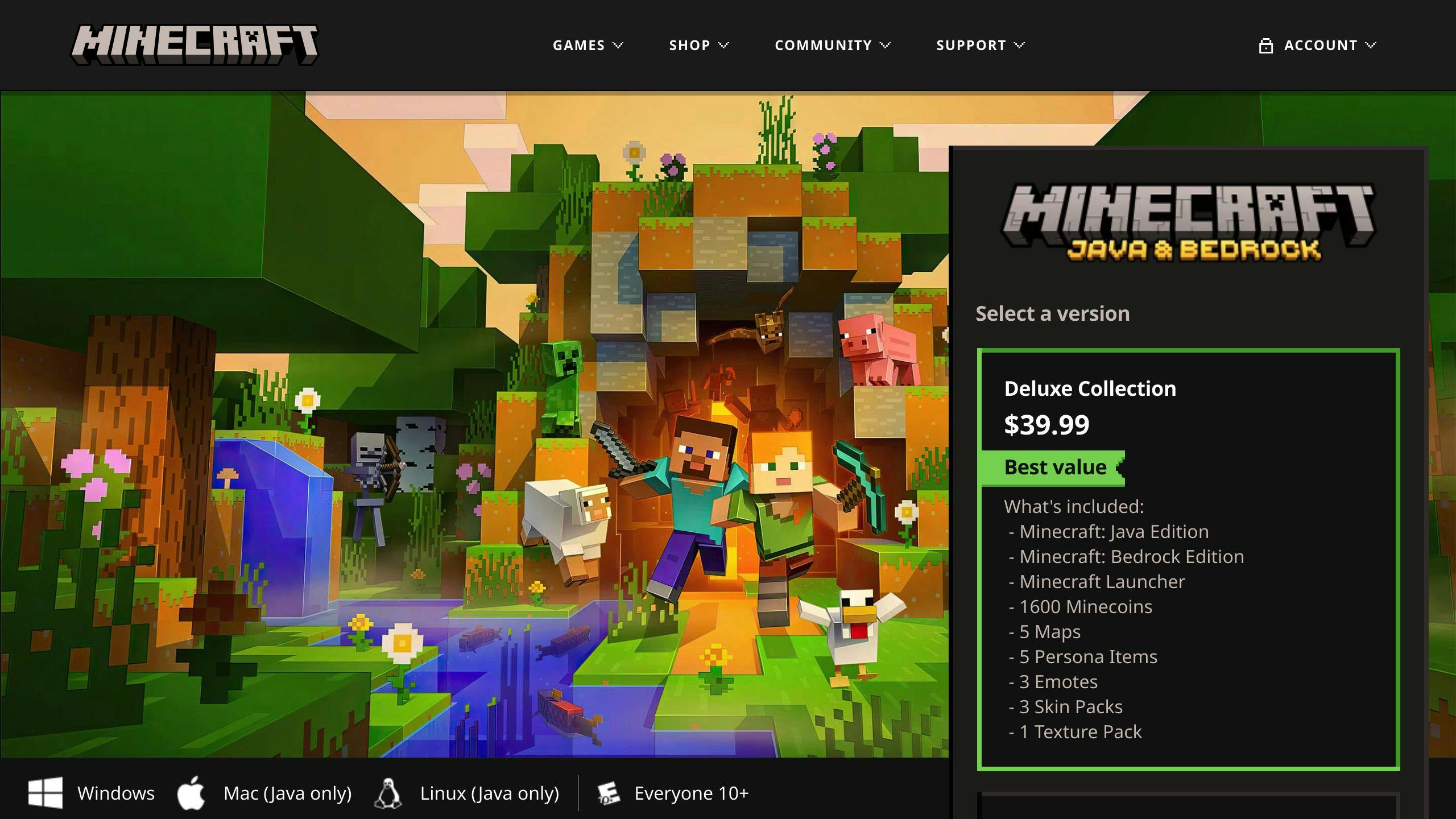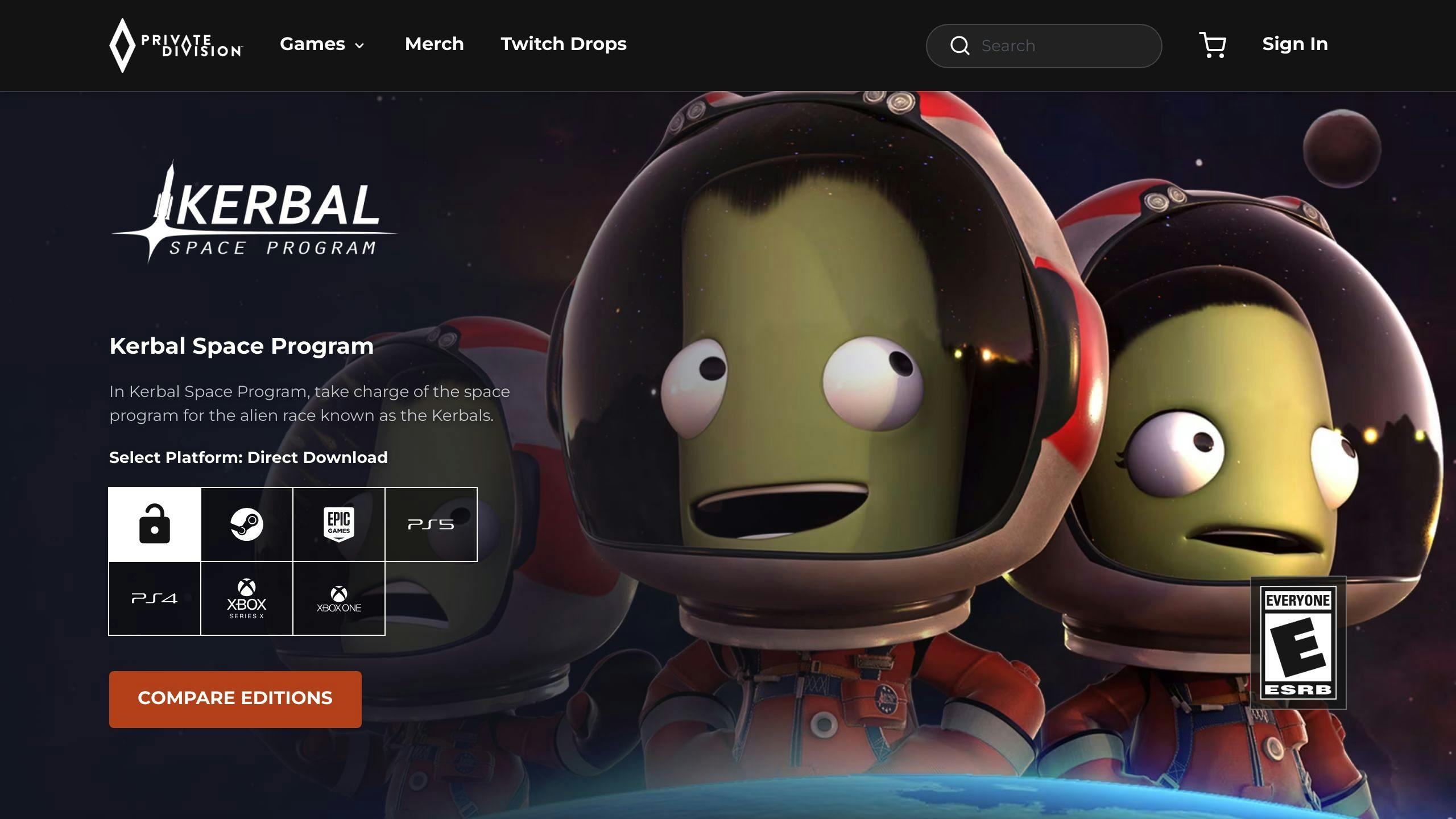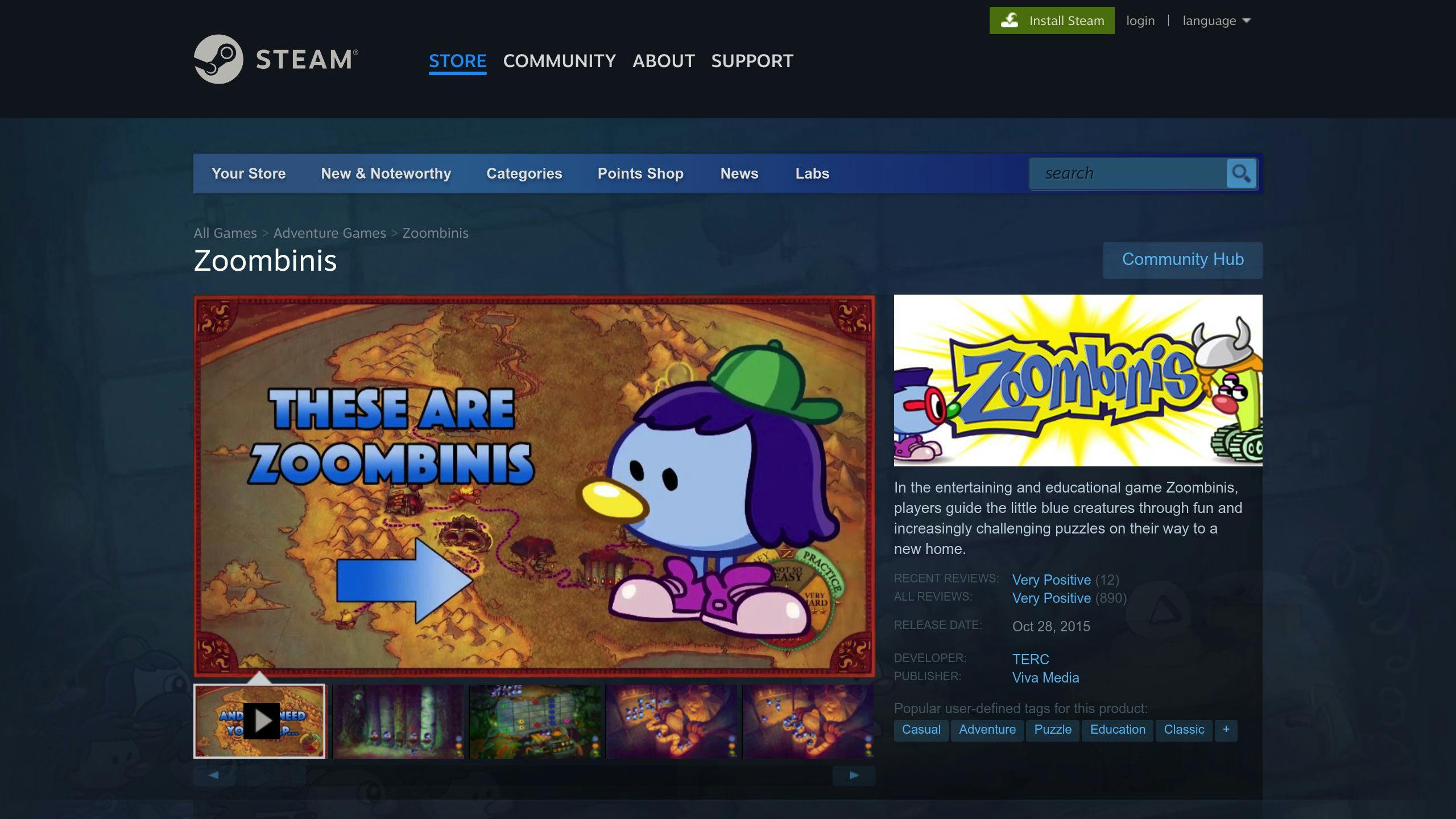
Easy Educational Games for Busy Parents
Looking for easy educational games to keep your kids engaged and learning? You're in the right place! This guide covers a variety of games that cater to different ages and learning needs, from board and card games to video games and outdoor activities. Here's a quick overview:
- Board and Card Games like Quiddler, The Sentence Zone, and Apples to Apples Junior focus on word building, sentence construction, and creative thinking.
- Video Games such as Minecraft and the Portal series enhance problem-solving skills, creativity, and understanding of complex concepts.
- Outdoor Activities like obstacle courses and sidewalk chalk games promote physical activity while reinforcing important educational concepts.
- Creative and Craft-Based Learning Games including DIY rainstorm projects and sun printing, encourage hands-on learning and exploration of scientific principles.
These games and activities are not only fun but also integrate seamlessly into your daily routine, making learning an enjoyable part of your child's day.
Enhance Communication and Collaboration
Games where kids play together teach them how to work as a team and talk things out. They learn how to share ideas and help each other. Even when playing alone, kids can talk about what they learned with friends or family, which is great for their social skills.
Teach Academic Concepts in an Engaging Format
Games make learning fun because kids can actually do things, not just sit and listen. They might explore a jungle while learning math or solve a mystery while improving their reading skills. This way, learning feels like an adventure.
Provide Scaffolded Challenges to Master Skills
Games often start easy and get harder as you go. This helps kids learn step by step, getting better as they play. They feel proud when they master a new level, which makes them want to keep learning.
In short, educational games mix fun with learning, making it easier for kids to pick up new skills and knowledge. They're curious by nature, and games use that curiosity to teach them in a playful way.
How to Choose the Right Educational Games
Choosing the right educational games for your kids can help them learn better while they play. Here's how to pick games that will be fun and helpful for your child's learning.
Select Games That Align With Your Child's Interests
- Think about what your kid likes, such as their favorite TV shows or books, and choose games related to those things. This makes the games more fun for them.
- For instance, if your child loves space, find a game that uses space to teach math or reading.
Ensure Games Match Your Child's Development Level
- Look at the age range on games to see if they're right for your child. They should be challenging but not too hard.
- If a game makes your child frustrated, it might be too difficult for them right now.
Look for Games That Focus on Specific Skills
- Choose games that help build certain skills like counting, reading, or solving puzzles. These games are more useful than ones just for fun.
- Focus on games that help with skills your child needs to work on.
Favor Games with More Interactivity
- Pick games where your child can make choices and do things, not just games based on luck.
- Games that have puzzles or challenges are better because they make your child think more.
Seek Out Adaptive Games That Change Based on Ability
- The best games change their difficulty based on how well your child is doing. This keeps the game just right for their level.
Offer Child Choice in Games When Possible
- Letting your child pick from games you think are good gives them a sense of control and makes them more interested in playing.
- But, avoid games that are too flashy or addictive without teaching much.
Choosing games this way helps make sure your child enjoys playing and learns something too. Remember to check if the games still fit your child's interests and skills as they grow.
Top Educational Board and Card Games
1. Quiddler
Educational Value
Quiddler is a card game that's all about making words with the cards you have. It's great for learning new words and getting better at spelling. The game is set up so that you can make it easier or harder depending on who's playing, which means it can help your child get better at words over time.
Ease of Setup and Play
Quiddler is easy to start. Just shuffle the cards, deal them out, and you're ready to go. The game moves quickly, keeping everyone interested. Plus, it's small and easy to take with you, so you can play it anywhere, making it a good choice for learning on the move.
Engagement Factor
The game is designed to be fun and keep kids wanting to play. They can play by themselves or with others, which is great for talking and playing together. As kids get better, they can try harder levels, which keeps the game interesting.
Accessibility for Various Ages
Quiddler works for different ages because it has three levels - one for shorter words, one for a bit longer words, and one for the longest words. This means young kids can play by making simple words, and older kids or adults can challenge themselves with longer words. It's a game that everyone in the family can enjoy together.
2. The Sentence Zone
Educational Value
The Sentence Zone is a game for kids between 7 and 12 years old that makes reading and writing better. It involves reading cards with sentences, using words like "and" or "but" to join sentences together, and fixing any mistakes. This helps kids get better at understanding and using language.
Ease of Setup and Play
Setting up this game is quick. You just mix up the cards, hand some out, and start making sentences. Everyone takes turns reading and fixing sentences, and a game can be done in 15-30 minutes. This makes it easy to play even when you're short on time.
Engagement Factor
Since kids are actively putting sentences together, they pay more attention. The game moves fast as everyone tries to create the best sentences. Plus, making funny sentences or stories keeps it fun.
Accessibility for Various Ages
The game uses colors to show different levels. Yellow cards are for easy sentences for younger kids. Green cards add a bit more challenge for older kids. Blue cards are the toughest, with harder grammar. This way, kids of any age can play at their level, and even adults can join in to show how it's done.
3. Apples to Apples Junior
Educational Value
Apples to Apples Junior helps kids learn new words, how to read better, and how to be creative when they talk. It's a game where kids match words and explain their choices, which is good for learning how to speak clearly. Plus, it's fun because it makes them think of funny or unusual word pairs.
Ease of Setup and Play
This game is quick to set up and the rules are easy to understand. You just mix the cards, give 7 to each player, and start with one green apple card. Games can be short (5-10 minutes), so it's perfect for a quick play or a longer game time. It's also easy to carry around, so kids can play it in different places.
Engagement Factor
Kids love the funny matches they make, which keeps them interested. They're eager to see if their card wins. The game also helps kids pay attention and enjoy time with others. Playing together makes everyone laugh and have a good time.
Accessibility for Various Ages
Kids from early reading age to 12 can enjoy this game. It has simpler words on the red apple cards for younger kids and harder words on the green apple cards for older kids. Adults can play too, showing kids how to explain their word choices. You can change which cards you use so that everyone can play together.
4. Settlers of Catan
Educational Value
Settlers of Catan is a game that teaches kids how to think carefully, use math, and get along with others. In the game, players collect stuff like wood and wheat to build things on a place called Catan. They need to plan well, do some math, and talk to other players to trade things. Playing this game a lot can make these skills better over time.
Ease of Setup and Play
The game has rules that are pretty easy to get. It takes about 15 minutes to learn how to play, and a whole game lasts between 60-90 minutes. You need to set up the game first by putting the board together and sorting out cards. But once that's done, kids can start making decisions on where to build and what to trade. This means they can quickly get involved in the game.
Engagement Factor
Kids stay interested because the game changes every time you play. They get to see what they can build next and how they can grow on Catan. Trading stuff with other players also keeps things fun. And because the winner isn't clear until the very end, kids stay excited to see who will win.
Accessibility for Various Ages
The game is best for kids 8 years old and up. But you can change some rules to make it easier for younger kids, like making the game shorter or needing fewer things to build. Older kids and adults can help the younger ones understand how to play. This way, everyone from different ages can have fun together.
5. Minecraft

Educational Value
Minecraft is a game where kids can be really creative, solve problems, work together, read, do some math, and lots more. In the game, they explore different places, collect stuff, make tools and buildings, and figure out puzzles. They might have to read instructions, figure out how much of something they need, or share resources with friends. There are even special versions for schools that help with learning.
Ease of Setup and Play
You can get Minecraft on lots of devices, and you either buy it once or pay a subscription. It takes a little bit to download, and there are guides to help you learn how to play. The basics involve moving around, mining, making things, and building. You can play by yourself or with others online. How long you play can vary, from a quick visit to hours of fun, depending on what you're doing in the game.
Engagement Factor
The game lets you decide what you want to do, like building your own castle or town, which makes it really fun. Playing with others lets you work on big projects together. Trying to stay safe at night and finding hidden treasures keeps it exciting. The game also gets updates, so there's always something new to see.
Accessibility for Various Ages
Minecraft is good for kids 8 and older, but younger kids can play too if someone helps them. There's a 'Creative' mode that's easier because there are no monsters or other dangers. As kids get better at typing and math, they can try more complicated things in the game. The game is rated for teens because of fantasy fighting. Parents can change settings to make sure the game is okay for their kids.
6. The Oregon Trail

Educational Value
The Oregon Trail game helps with thinking skills, solving problems, and learning about history. Players choose what to bring on their journey, decide how to travel, and solve problems like sickness. These choices teach about the challenges people faced moving west in the 1800s. Making good choices helps players do better in the game.
Ease of Setup and Play
The game has been made new for today's players. The board game version needs you to get cards and pieces ready. Digital versions on phones, computers, and game systems are easier to start with help from tutorials. A game can last about an hour or an hour and a half.
Engagement Factor
The Oregon Trail keeps you interested by letting you pretend to be on an adventure with important choices to make. The game changes as you play, with different things happening that affect your journey. Getting to the end of the 2,000 mile trip feels like a big win.
Accessibility for Various Ages
This game is best for kids 8 years old and up because it needs thoughtful decision-making. Younger kids can still play with some help. Adults who know about the history can make the game more interesting by talking about the events and choices in the game. It's a way for everyone to learn about history.
7. Wordscapes
Educational Value
Wordscapes is a game that makes kids better at spelling and knowing more words. It's like a puzzle where you find hidden words in a bunch of letters. This game is good for learning because it makes kids think about how letters come together to make words. With over 500 puzzles and 20 levels, there's always something new to learn.
Ease of Setup and Play
Wordscapes is a game you can get on your phone for free. To play, you just tap the letters to form words. It's easy to get into. You can solve a few puzzles quickly or keep playing for longer. The game keeps track of where you are, so you can stop and start anytime.
Engagement Factor
The game keeps kids interested by challenging them to find all the words. As they get better, they unlock new kinds of puzzles that make it even more fun. The game looks nice too, with pictures of places like beaches and forests. Kids also like earning stars and coins for doing well.
Accessibility for Various Ages
Wordscapes is great for kids who are 8 and older and already know how to read a bit. The first levels are easier, with short words. But as you go on, it gets harder with longer words. Even adults can enjoy the tough levels. The game adjusts so it can be just right for different ages.
8. Portal Series

Educational Value
The Portal series is all about using your brain to solve puzzles. It makes you think about how to use portals to move around and solve challenges. You'll need to use your understanding of space, and sometimes a bit of math and science, to figure things out. It's a fun way to get better at thinking through problems.
Ease of Setup and Play
You can play Portal on computers and some game consoles. After you buy and download it, there's a quick guide on how to play. Each puzzle takes a little time to solve, and you can save your game whenever you need to.
Engagement Factor
People really like the Portal games because they're fun and make you think. The puzzles get harder as you go, which keeps you interested. The story and characters in the game also make it more enjoyable. You can even play with a friend in some parts of the game.
Accessibility for Various Ages
Portal is recommended for teens, and Portal 2 is good for kids 10 and up. This is because of the game's challenge level and some scary parts. But, Portal 2 is a bit easier and less scary, so younger kids might be okay with it. It's still a good idea for parents to check it out first.
9. KLASK
Educational Value
KLASK is a fun game that teaches you how to aim and plan ahead using magnets to move a ball into a goal. It helps improve how well you can see and react to things moving, think through your moves, and solve problems on the spot. This game is good for learning how to judge space, make quick decisions, and figure out puzzles.
Ease of Setup and Play
Setting up KLASK is easy. You just need to put its game board on any flat area, place the ball in the center, and you're all set to play. Matches are short, about 10-15 minutes, so kids stay interested from beginning to end. It's also easy to carry around, making it perfect for play anywhere.
Engagement Factor
Kids get really into KLASK because it's like playing a fast-paced sport. They have to move quickly to control their magnet and protect their side. The game keeps everyone on their toes with exciting moments and close scores. It's a hit because it's thrilling and makes you think fast.
Accessibility for Various Ages
KLASK is best for kids 8 years old and up because it's a bit tricky, but younger children can also enjoy it with a little help. The game starts simple, but as you play more, you can try out different moves. It's fun for both kids and adults, and you can play one-on-one or in teams.
10. Obstacle Courses
Educational Value
Obstacle courses are a fun way for kids to get better at moving, thinking on their feet, working together, and feeling good about what they can do. They have to do things like climb, crawl, and balance, which is good for their bodies and brains. Trying to get through tough spots teaches them to keep going even when it's hard.
Ease of Setup and Play
You can make obstacle courses at home with stuff you have around, like pillows, blankets, boxes, and hula hoops. You can look up how to do it online. You can make them easy or hard, and they don't take long to set up or clean up. Just be sure to talk about being safe first. The whole thing can be done in about 15-30 minutes.
Engagement Factor
Kids really like obstacle courses because they're fun and active. They get to run around and be playful. If you make it a bit of a race, it's even more fun. Letting kids help make the course means they're more into it because they helped build it.
Accessibility for Various Ages
Obstacle courses are great for kids of all ages. Little kids can have simpler tasks, and older kids can have puzzles or harder challenges. Grown-ups can show how to do things safely and help out kids who need it. It's important for kids to try hard things but stay safe.
11. Sidewalk Chalk Games
Educational Value
Sidewalk chalk games are a great way for kids to learn outside. They can practice numbers, letters, shapes, and colors while playing. These games also help kids get better at moving and aiming by following lines or hitting targets. It turns learning into fun outdoor play.
Ease of Setup and Play
All you need for sidewalk chalk games is some chalk and a flat spot outside. You can quickly draw things like hopscotch or numbers for games. When you're done, just sweep or hose off the area.
Engagement Factor
Kids enjoy using chalk to draw and play, making these games very engaging. They can keep playing different games or drawing new ones. Plus, it's a good way for them to be active and use up energy.
Accessibility for Various Ages
Chalk games are good for young kids and older ones too. Younger kids can work on basic writing by tracing. Older kids can play more complicated games that involve spelling or math. It's also a chance for the whole family to play together.
12. Gardening
Educational Value
Gardening is a fun way for kids to learn about being responsible, having patience, and taking care of things. It shows them where food comes from and how plants grow. They also get to learn about science and math by doing things like counting seeds and measuring how big the garden is. Gardening makes learning real and hands-on.
Ease of Setup and Play
To start a garden, you need to plan a bit. Find a place that gets a lot of sun, check the dirt, choose easy plants, and get pots or tools ready. Planting day can be a special family activity. Taking care of the garden, like watering or pulling weeds, only takes a few minutes each day. Kids should definitely help with this. When the season ends, you pick what you grew and get the garden ready for next year.
Engagement Factor
Kids really like to play in the dirt, watch plants grow, and see flowers and veggies come up from the seeds they planted. You can make it more fun by choosing plants that attract butterflies or other small animals. If kids have their own small garden spot or pot, they'll be more excited to take care of it. You can turn garden work into games and even throw a little party when things start to grow.
Accessibility for Various Ages
Little kids can help with simple things like watering plants or picking easy-to-grab veggies. Kids who are a bit older can plant seeds, make garden signs, and take care of their own part of the garden. Everyone can help with putting food scraps in the compost. Adults should use the sharp tools but can do other garden work with the kids.
13. DIY Rainstorm
Educational Value
Making a DIY rainstorm is a fun way to learn about weather and science. Kids can explore how rain is made and falls from clouds. This activity encourages them to ask questions and think like scientists while they play.
Ease of Setup and Play
You only need a few things like shaving cream, food coloring, and a plastic container. Fill the container with shaving cream to make 'clouds' and then drop colored water onto it to make 'rain'. It's quick to set up and easy to clean with water. The whole thing can be done in about 10-15 minutes.
Engagement Factor
Kids usually love making messes and seeing the colors mix as they play with the rainstorm. It's fun to watch the 'rain' go through the 'clouds'. They also like pretending to control the weather. This activity keeps them interested by letting them see and make something that happens in real life.
Accessibility for Various Ages
Kids of all ages can enjoy this. Younger children will like mixing colors and watching the rain, while older kids can learn more about how rain works. Everyone can learn something, and it's safe for younger kids with an adult to help.
14. Sun Printing
Educational Value
Sun printing is a cool way to learn about how the sun affects things. It shows kids the science behind how sunlight changes special paper. They'll see how shadows and light create pictures, teaching them about how light works. This activity is great for getting kids to think, watch closely, and be creative.
Ease of Setup and Play
Starting sun printing is pretty straightforward. You just need special paper, some objects to create shadows, and a sunny spot. Put the objects on the paper in a fun pattern, then leave it in the sun for a few minutes. After that, you just rinse the paper in water, and your picture shows up. The whole thing takes about 10-15 minutes.
Engagement Factor
Kids love doing sun prints because it's exciting to see their pictures come to life. Every print turns out different, depending on what you use and where the light shines. Trying out different shapes and seeing what happens keeps them interested. It's a fun way to mix art with science.
Accessibility for Various Ages
Little kids can make simple prints using large objects like leaves or their hands. Older kids can try more complex designs with smaller items, which helps with their fine motor skills. As long as an adult is there to help with the water part, kids of all ages can have fun with this. It's a neat way to get curious about the world.
15. Build 3D Shapes
Educational Value
Building 3D shapes with items like clay, toothpicks, straws, or building blocks is a great way for kids to learn about shapes and space. As they put together shapes, they learn about the different sides and angles. This activity also helps them with math because they have to think about size and measurements. Making shapes that they can hold and look at from all sides makes it easier to understand geometry.
Ease of Setup and Play
This activity is easy to start. You just need some things from around the house and maybe some glue or tape. You can find simple instructions online to help make different shapes. Simple shapes might take a few minutes, but more complicated ones could take longer. Let kids work at their own speed.
Engagement Factor
Kids usually like making things with their hands, especially when they can be creative. Trying to follow instructions or copy a shape can keep them busy. They feel proud when they finish making something. Making shapes this way is more fun than just drawing them on paper.
Accessibility for Various Ages
Young kids can make simple shapes like cubes and pyramids with playdough. Older kids can try harder shapes using things like toothpicks and marshmallows. Grown-ups can help the little ones with tricky parts and let the older kids do more on their own. Working together can also be fun. This way, kids of different ages can all find something they can do.
16. Make Your Own Weather Tool
Educational Value
Building a barometer at home is a cool way to learn about the weather and air pressure. Kids get to see how air pressure changes and how it affects the weather. It's a hands-on way to see science in action.
How to Set It Up and Use
You'll need some simple things like a glass jar, cardboard, a straw, and tape. An adult should help collect these items and assist with the setup, which takes about 30 minutes. Kids can then check their barometer every day, which only takes a couple of minutes. Watching the barometer and talking about the weather is a great learning moment.
Why It's Fun
Kids are naturally curious about the weather. With their own barometer, they can watch the air pressure go up and down. Predicting the weather and seeing if they're right is fun. Decorating their barometer adds a personal touch.
Good for All Ages
Younger kids might need help making the barometer, but older ones can do a lot by themselves. Kids of any age can help collect items and make it look nice. Once it's ready, even the youngest can help check it and learn about the weather. Explaining how it works makes it interesting for everyone.
Best Educational Video Games
Video games often seem just for fun, but many are made to help kids learn while they play. These games teach about subjects like science, math, history, and more, making learning exciting.
For busy parents, educational video games are great because they:
- Turn learning into a game so kids pay attention
- Adjust to how well your child is doing to keep it interesting
- Let kids play on their own, giving you time to do other things
- Use pictures and sounds to make learning more fun
Here are some great educational video games for your kids:
1. DragonBox Algebra
DragonBox Algebra turns math into a quest with fantasy characters and puzzles. Kids solve problems in the game and learn about math without even realizing it.
Good for ages: 5 years old & up
Topics: Early math, algebra
Platforms: iOS, Android, Nintendo Switch, PC
Why kids love it: It feels like a fun adventure but helps with math.
2. National Geographic Challenge

This game takes kids around the world with geography questions about places, cultures, and history. It has over 1,000 quizzes and shows cool photos and videos.
Good for ages: 8 years old & up
Topics: Geography, social studies, general knowledge
Platforms: Nintendo Switch, PlayStation, Xbox, PC
Why kids love it: It's like exploring the world and seeing amazing places.
3. Oregon Trail
The Oregon Trail game lets kids learn about life as a pioneer. This new version keeps the fun of the original but adds new parts. Kids make decisions and solve problems as they move out West.
Good for ages: 8 years old & up
Topics: American history, critical thinking
Platforms: iOS, Android, Nintendo Switch, PC
Why kids love it: They learn history and make choices that change the game.
4. Kerbal Space Program

Kids design rockets in Kerbal Space Program, learning about space and rocket science. They try different designs to see what works best for exploring space.
Good for ages: 10 years old & up
Topics: Rocket science, astrophysics
Platforms: PlayStation, Xbox, Nintendo Switch, PC
Why kids love it: Designing rockets and seeing them fly is fun.
5. Zoombinis Logical Journey

Zoombinis is a game where kids guide creatures through puzzles. The puzzles get harder and help kids get better at thinking and solving problems.
Good for ages: 6 years old & up
Topics: Logic, critical thinking, problem solving
Platforms: iOS, Android, Nintendo Switch, PC
Why kids love it: The funny characters and story make learning fun.
With so many educational games available, you can find ones that your kids will enjoy and learn from. Try different games to see what your children like best.
sbb-itb-7aa0ffe
Fun Physical and Outdoor Educational Activities
Getting kids to play outside is not just good for their health, but it's also a great way to help them learn. Here are some simple and fun outdoor learning activities:
Obstacle Courses
- Helps with moving skills and thinking through problems
- You can use things like boxes, hula hoops, and blankets from home
- Make it easier or harder depending on who's playing
- Takes about 15-30 minutes to do
Sidewalk Chalk Games
- Good for practicing numbers, letters, shapes, and colors
- Helps with writing and drawing skills
- Create games like hopscotch or draw targets for throwing games
- Quick to start and easy to clean up
Nature Scavenger Hunts
- Great for exploring nature and learning science
- Search for different plants, bugs, or rocks
- Teaches how to look closely and learn about what you find
- Fun way to learn about the world around us
Leaf and Flower Pressing
- See the details in leaves and flowers up close
- A creative way to learn about plants
- Make art from what you find
- A fun, hands-on science lesson
Sun Printing
- Learn about how sunlight creates images
- Shows how light and shadow work
- A creative science project for all ages
- Simple to do and fascinating to watch
Cloud Watching
- Learn about different types of clouds and what they mean
- A gentle introduction to weather and science
- Use your imagination to see shapes in the clouds
- A calm and fun way to learn outdoors
These outdoor activities are all about learning by doing. They make it easy to teach kids important lessons while they have a great time.
Creative and Craft-Based Learning Games
Educational games that involve arts and crafts are a great way to help kids learn while they have fun. These activities use kids' natural interest in making things to teach them different skills. Here are some creative educational games that are perfect for busy parents:
1. DIY Rainstorm
- Teaches kids about weather, clouds, and how rain is made
- Lets kids try out mixing "clouds" and "rain" with things you have at home
- Quick and easy to set up
- Keeps kids busy with hands-on activities
2. Sidewalk Chalk Games
- Helps with learning numbers, letters, and colors through drawing
- Encourages kids to play outside
- You can start playing with just chalk and a flat surface
- Includes fun games like hopscotch and drawing targets for practice
3. Paper Bag Puppets
- Encourages creativity and storytelling
- Can be about anything from animals to favorite characters
- Uses paper bags and simple craft supplies
- Shows kids how to make toys from everyday items
4. Nature Jewelry
- Combines art and science by making jewelry from things found in nature
- Teaches kids to notice the different colors and shapes outside
- Good for practicing how to use small muscles in the hands
- Kids can wear and share what they make
5. Egg Carton Crafts
- Turns egg cartons into art projects and toys
- Teaches kids about recycling and caring for the environment
- Involves painting, cutting, and building
- A fun way to reuse something you have at home
These games mix learning with fun and creativity. They mostly use things you already have around the house. Making these crafts together is a good way to spend time with your kids and help them learn.
Incorporating Learning into Everyday Activities
Turning daily activities into learning moments is a smart way to teach your kids new things without needing extra time. Here are some simple ways to do it:
Cooking and Baking
- Math practice comes from measuring ingredients or changing recipe sizes.
- Science lessons happen by watching how things mix and change with heat.
- Reading skills grow by going through recipes.
- Thinking skills develop by following steps in order.
- Learning about the world by trying foods from different places.
Kids can help with tasks like mixing, measuring, and more, depending on how old they are.
Shopping
- Math and money lessons come from looking at prices and adding them up.
- Planning and budgeting by deciding what you need and what you can skip.
- Reading practice by looking at signs and labels.
- Discovering new cultures by exploring foods from around the world.
Let kids help with making the shopping list and finding items in the store.
Chores
- Teaching responsibility by having them do regular chores.
- Sorting and organizing skills come from tasks like laundry or tidying up.
- Measurement practice in cooking, watering plants, or feeding pets.
Choose chores that fit your child’s age and what they can do. Say well done when they finish.
DIY Projects
- Thinking skills from following instructions and looking at diagrams.
- Math skills needed for measuring and planning projects.
- Spatial thinking with activities like decorating or moving things around.
- Creativity and fine motor skills through arts, crafts, or small fixes.
Pick projects that your child likes and can do. Work on them together.
Making everyday life a learning experience is a great way to spend time together. Keep it light and fun by working as a team!
Conclusion
Picking the right games and activities for your kids means finding a good mix. You want them to enjoy their playtime but also learn something new.
The games and activities we've talked about are designed to be fun for kids while teaching them about things like reading, writing, math, and science, all through playing.
When choosing games, think about ones that:
- Are interesting to your child
- Are right for their age and how much they can understand
- Let them be a big part of the action
- Can change to fit what they need
- Help bring your family closer together
This approach keeps learning enjoyable instead of making it feel like a chore. Try to mix up the games and activities between easier ones and those that are a bit more challenging. This helps kids learn new things while feeling good about what they can do.
Most of all, try to play with them. Whether it's board games or drawing with sidewalk chalk, learning together makes everyone feel closer and helps kids' minds grow.